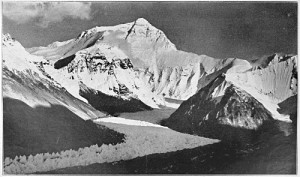Headaches, dizziness, fatigue – those and more symptoms are familiar to many that have ventured into heights beyond 3000m. High-altitude illness or Acute Mountain Sickness (AMS) is a lingering risk for trekkers and climbers but it is often treated as a secondary concern. It presents mostly as a nuisance that makes a tough environment even more demanding. It can, however, quickly develop into a serious and potentially lethal condition. Like me, you might now think ‘okay, but I’ve prepared well and have no pre-existing conditions, I should be fine’. But research shows, this can be a serious fallacy. Let’s take a closer look.
Today we have a wealth of information about AMS thanks to countless expeditions and a large body of medical research. Back in the pioneering days of Albert Mummery, Fanny Workman, George Mallory or even still at the time of Hermann Buhl, mountaineers were in a less privileged position. They had to rely on their experience from much lower mountains as well as some vague ideas about the problems with ‘thin air’. The effects of an oxygen-scarce environment on the human physique were largely based on personal perceptions. But they did not neglect the issue as can be deduced from various expedition logs and diaries. Mallory describes many detailed observations in his writings on the reconnaissance of Everest in 1921: “Bullock’s [Guy Bullock] appetite […] was notably deficient during the first three weeks for someone who was working his body so hard; and he was short of sleep at our highest camps.” He explains further: “Some other members of the expedition seemed not to be quite at their best at 20,000 feet, and at Lhakpa La were imperfectly refreshed by the night’s rest”. Mallory reports proudly that he was barely affected, eating “large quantities of solid food, mutton potatoes, Quaker Oats, …” (which probably has to be taken with a pinch of salt as he later complains about fatigue and mentions the stronger effect of mental stress at altitude). But he struggled to find a pattern; different people were affected at different times and altitudes, without any clear regularity. Almost 30 years later, Maurice Herzog’s accounts from the successful ascent of Annapurna make it clear that knowledge about high-altitude illness was still hit and miss. They understood the importance of gradual acclimatization but acted on it without particular consistency. Furthermore, Herzog and Louis Lachenal took sleeping pills even at very high altitude; a practice now highly discouraged because of the interference with breathing and the potentially exacerbating effect on AMS.

So what have learned in the meantime? AMS can start as low as 2500m but in most cases only triggers harmless symptoms. At an altitude of 6000m, however, the atmospheric pressure is only at 50% compared to sea level meaning that every breath only delivers 50% of the oxygen. This leads to lower oxygen saturation in the blood and thus less oxygen is delivered to the internal organs. The body compensates by increasing the capacity to absorb and transport oxygen but this takes time and the ability differs between people. If the acclimatization is not quick enough, the resulting hypoxia can cause swelling in the brain (HACE) and fluid in the lungs (HAPE) – both very dangerous and potentially lethal as they quickly reduce mental and physical ability. Gradual acclimatization is key and the CDC recommends increasing the sleeping altitude by no more than 500m a day above 3500m. A summary of risk factors and preventive actions can be found on the CDC website.
In fact, previous occurrences of AMS, the speed of the ascent, and the extent of previous acclimatization are the most reliable predictors for future problems with altitude [see Schneider et. al. ’02]. This boils down to little more than saying high-altitude related problems are very difficult to predict unless you already know that you are very susceptible. But it indicates that it is an individual characteristic. So it is not surprising that while Malory was still happily munching his Quaker Oats, John Krakauer was feeling the strain: “The altitude here [at 21,300 feet] manifested itself as a malicious force […]. Too miserable to eat or even read…” [Into Thin Air, p.107]. However, this was not due to their potential differences in climbing skill and physical fitness but, at this point, can only be explained as random individual differences.

In terms of understanding the causes of high-altitude sickness, there still is plenty of work to do. But we have a much better understanding of how to minimize the risk before it occurs and treat the complications if it does occur. Given all this information, we should avoid the pitfall that AMS is something that affects the poorly prepared and unfit. It is not surprising that many tour operators brush away the potential seriousness in an attempt to get customers to their objectives quicker (and thus increase the turnover). While the overall probability of contracting serious symptoms might still be considered small, the consequences can be severe and shouldn’t be neglected. And since it can happen to everyone, a reasonable rate of ascent should be an appropriate precaution even for the most skilled.
DISCLAIMER: This is a general interest article and does not constitute any medical advice. As such, it is necessarily incomplete. No guarantees whatsoever are given regarding the accuracy and appropriateness of the information and no responsibility of any kind is taken. Always consult a medical professional for medical advice.